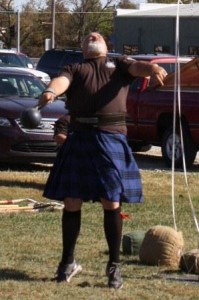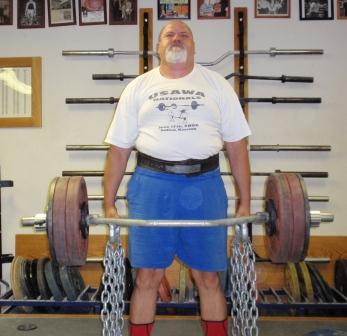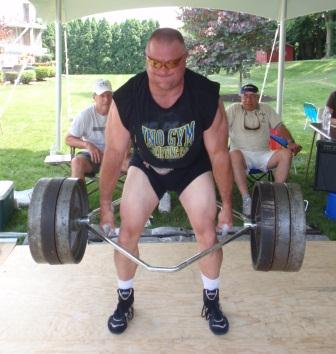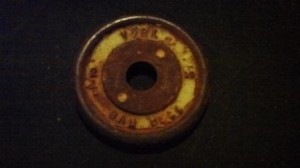by Thom Van Vleck

Thom Van Vleck tossing the 42lb weight at the 2011 Kirksville Games
Some of you may know that several of our USAWA members are currently, or have been, participants in the Scottish Highland Games. These are strength events, but mostly involve throwing or tossing weights. One of the events, and my personal favorite, is the “Weight Over Bar”. I thought I might give a little background on this event, discuss the rules, and explain why I think throwing this type of movement into your training occasionally might be a good way to mix things up and avoid a training rut.
This event involves throwing a weight with a handle over a cross bar for height using one hand only. Women use a 28lb weight, masters men and under 190lb throwers use a 42lb weight, and all other men use a 56lb weight. It is thought the weights were originally balance beam scale weights. In the old system in Scotland a “hundredweight” equaled 112lbs. Half that was 56lbs and half that was 28lbs. A “stone” was 14lbs and the 42lb weight was half way between the 28 and 56. So, basically the 28 was 2 stones, the 42 was 3 stones, and the 56 was 4 stones! It should be noted old English Anvils also used this measuring system and that is why if you find an English anvil and it says 112 on the side, it’s NOT 112lbs, but 1 hundred weight (112lbs), 1 Quarter Hundred weight (28lbs) and then 2 odd pounds. So it would be 112 + 28 + 2 = 142lbs! I know, pretty complicate, just know in the Highland games we throw a 28lb, a 42lb, and a 56lb weight!
There are two ways to get the weight over the bar. You can “stand” and basically do what would be a “super one hand snatch” and pull the weight up and over your head and over the bar. Or you can do the “spin” and basically do a “turn” (much like the rotation on the shot put). That technique is not widely accepted (such as by our USAWA secretary!) plus it’s very difficult to master so unless you are going to take this up as a sport let’s focus on the standing style. Typically, in competition, you would have “standards” that look much like a high jump bar or pole vault set up. The bar goes up until only one competitor is left. Out of the 9 events in the Highland Games, this is the most basic. It requires the least technique and is often dominated by the strongest athletes.
That is why I think it would make a good training tool to add to the rotation of your training routine. It would be a good event to use to train for the one arm snatch, the DB Swing, DB Snatch….any movement where you have to move the bar quickly from the floor to overhead! You could use a kettlebell to practice this event, or a solid dumbbell. Since the idea is to throw it as high as possible I would only do this outside where the weight can fall safely on the ground. Use a weight you can get up in the air 12 to 15ft. You don’t need a cross bar, just get out there and get some rips in and see what happens. Pulling a weight hard enough to toss it several feet over your head should develop explosive power and speed. Plus, it’s just a lot of fun! If you do it in your back yard you can give your neighbors something to talk about!
Sometimes this event is called the Weight for Height. I have no problem with this, but just so you know it is thought the Weight for Height actually refers to how the Irish would perform this event. Instead of tossing the weight over a bar (the term “toss” is used whenever you speak of height events and “throw” whenever it is a distance event) you have a target, often made of wood, hanging in the air and you try and hit the target. If you hit it, it is raised and you go again. Some of the other rules for the Weight Over Bar include you have three tries at each height. If you make it, the bar goes up and you get three fresh attempts. So, in competition it’s not unusual to take 5, event 10 or more attempts.
So, mix up your training a little, the kilt is optional! Try some Weight Over Bar!



